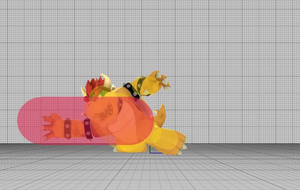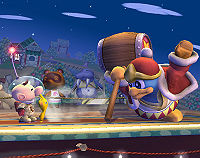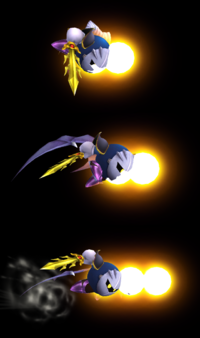Pivot grab
| “ | While dashing, press the direction opposite your current heading while performing a grab. You’ll get more range out of this kind of grab, so try pulling a 180 and scooping up your unsuspecting opponent with it. | ” |
| —Quick Techniques, Smash Bros DOJO!! | ||



A pivot grab (ふりむきつかみ, Turned-around grab) is a type of grab that any character can use. While dashing, a character can pivot in the other direction, but at that exact same moment of pivoting, the player can press the grab button. In Brawl, SSB4 and Ultimate, this results in a grab that has longer reach than most normal grabs. The pivot grab can help grab opponents that constantly roll behind opponents that are dashing, and is useful as well as if a character predicts an unsafe approach.
Pivot grabs generally have less ending lag than a character's dash or standing grab. For some characters with extended grabs, this lag is substantially shorter; Yoshi, Ivysaur, and Lucas have pivot grabs that are so much faster to end than their normal grabs that it is their preferred method of grabbing. However, other characters with extended grabs (Samus, Zero Suit Samus, Link, and Toon Link) do not have this advantage, with pivot grabs not much faster than their normal ones.
Characters with high running speed and low traction cover more ground while pivot grabbing, resulting in a minor range increase.
In Super Smash Bros. Melee[edit]
Pivot grabs in Melee are different from the pivot grabs present in later titles, and can only be done out of the turn animation after the initial dash, not the run. Their hitboxes and animation is no different from normal standing grabs, though, and there is only one frame during the dash dance turnaround where it can be done. Regardless, the Melee pivot grab is still very useful, often being used to extend hard chain grabs or space around quick moves like Fox's or Falco's Reflector for a grab.
In Super Smash Bros. 4[edit]
Due to the universal nerfs in mobility options (such as the removal of wavedashing, the dash pivot cancel and the DACUS, as well as the nerf to dash-dancing), pivot grabs are seen much more frequently than in Melee. Pivot grabs in SSB4 are functionally identical to pivot grabs in Brawl, and are used for various reasons, usually as a part of a read. Like in Brawl, compared to grabs and dash grabs, pivot grabs are usually the slowest startup-wise, but have the longest range. Because of that, correct timing and spacing will justify their overall safety. Characters with useful back throws or a fast running speed (such as Ness and Sonic) benefit the most in the scenario when they head towards the ledge, turn around and grab, putting the opponent at an extremely bad situation. Characters with short-ranged or slow grabs (such as Yoshi, Robin and Ganondorf) can also benefit a lot simply from the range increase. As shown in one of the images on this page, Bowser's pivot grab in SSB4 is quite infamous for its disjointed range.
In Super Smash Bros. Ultimate[edit]
On the surface, pivot grabs are functionally unaltered from SSB4, aside from some of the more notorious pivot grabs having their range toned down. However, their usefulness has been dramatically hindered by two new mechanics, the first one being the inability to run through grounded opponents, and the second being that almost all grabboxes, including those of pivot grabs, have about half the width against airborne opponents than they do against grounded opponents. These two changes considerably hinder the two main use cases for pivot grabs, making them less useful compared to previous titles.